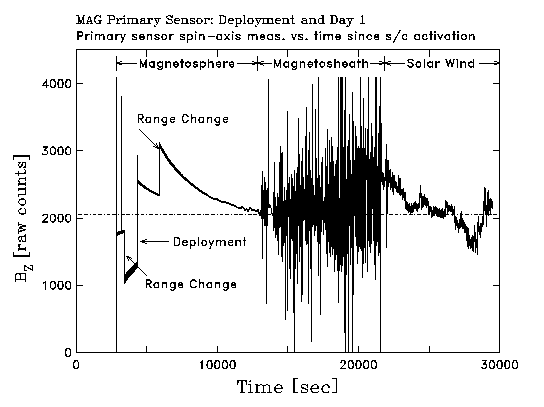First Data from the
Magnetometer Instrument (MAG)

 The MAG sensor was the first ACE instrument turned on, shortly after launch
on 8/25/97. Shown above is the spin-axis component of the magnetic field
as measured by the MAG Primary sensor on the first day of flight. The value
of a zero magnetic field is ~2000 in raw counts. Values greater than this
are increasingly positive and values less than this are increasingly negative.
MAG activation is at ~3000 seconds after spacecraft activation. Following
automated internal checks, the instrument autoranges to the appropriate
range for the ambient magnetic field. Two automatic range changes can be
clearly seen at other times in the figure. The MAG boom deployment is evident
as the spacecraft transits the quiet magnetosphere. The MAG boom deployment
reverses the direction of the Z-axis of the sensor, thereby changing the
sign of the measured field. Throughout the transit of the magnetosphere
the magnitude of the magnetic field decreases while range changes provide
increased count rates and increased sensitivity. The subsequent transit
of the turbulent magnetosheath places the spacecraft in the upstream solar
wind near the end of the first day of flight, at which time it was about
10 Earth radii away (~64000 km). Changes in sign of the solar wind magnetic
field are normal and expected. Preliminary examination reveals an instrument
that is functioning as designed with the onboard FFT and Snapshot buffers
working correctly.
The MAG sensor was the first ACE instrument turned on, shortly after launch
on 8/25/97. Shown above is the spin-axis component of the magnetic field
as measured by the MAG Primary sensor on the first day of flight. The value
of a zero magnetic field is ~2000 in raw counts. Values greater than this
are increasingly positive and values less than this are increasingly negative.
MAG activation is at ~3000 seconds after spacecraft activation. Following
automated internal checks, the instrument autoranges to the appropriate
range for the ambient magnetic field. Two automatic range changes can be
clearly seen at other times in the figure. The MAG boom deployment is evident
as the spacecraft transits the quiet magnetosphere. The MAG boom deployment
reverses the direction of the Z-axis of the sensor, thereby changing the
sign of the measured field. Throughout the transit of the magnetosphere
the magnitude of the magnetic field decreases while range changes provide
increased count rates and increased sensitivity. The subsequent transit
of the turbulent magnetosheath places the spacecraft in the upstream solar
wind near the end of the first day of flight, at which time it was about
10 Earth radii away (~64000 km). Changes in sign of the solar wind magnetic
field are normal and expected. Preliminary examination reveals an instrument
that is functioning as designed with the onboard FFT and Snapshot buffers
working correctly.
See a video of the deployment [480KB
file runs 8 seconds] 
.
ACE/MAG Project
Contributed by
Dr. Charles Smith,
Bartol Research Institute, Univ. of Delaware.
|